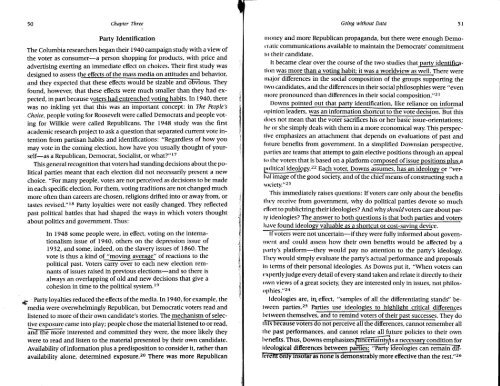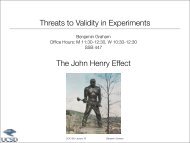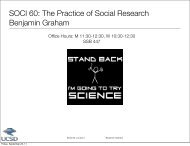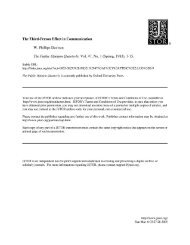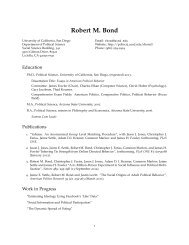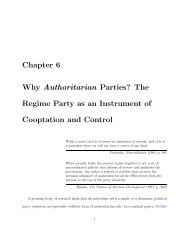Popkin-Reasoning Voter-Ch 3.pdf
Popkin-Reasoning Voter-Ch 3.pdf
Popkin-Reasoning Voter-Ch 3.pdf
Create successful ePaper yourself
Turn your PDF publications into a flip-book with our unique Google optimized e-Paper software.
* Partyloyalties reduced the effects of the media. tn lgk},forexample, the<br />
50 <strong>Ch</strong>apter Three_<br />
Party Identification<br />
The Columbia researchers began their l94O campaign study with a view of<br />
the voter as consumer-a person shopping for products, with price and<br />
advertising exerting an immediate effect on choices. Their first study was<br />
designed to assess t n attitudes and behavior,<br />
and they expected that these effects ous. They<br />
found, however, that these effects were much smaller than they had expected,<br />
in part because voters had entrench s. In 1940, there<br />
was no inkling yet that this was an important concept: in The People's<br />
<strong>Ch</strong>oice, people voting for Roosevelt were called Democrats and people voting<br />
for Willkie were called Republicans. The 1948 study was the first<br />
academic research project to ask a question that separated current vote intention<br />
from partisan habits and identifications: "Regardless of how you<br />
may vote in the coming election, how have you usually thought of yourself-as<br />
a Republican, Democrat, Socialist, orwhat?"rT<br />
This general recognition that voters had standing decisions about the political<br />
parties meant that each election did not necessarily present a new<br />
choice. "For many people, votes are not perceived as decisions to be made<br />
in each specific election. For them, voting traditions are not changed much<br />
more often than careers are chosen, religions drifted into or away from, or<br />
tastes revised."rs Party loyalties were not easily changed. They reflected<br />
past political battles that had shaped the ways in which voters thought<br />
about politics and government. Thus:<br />
In 1948 some people were, in effect, voting on the internationalism<br />
issue of 1940, others on the depression issue of<br />
1932, and some, indeed, on the slavery issues of 1860. The<br />
vote is thus a kind of "ry'-!gaverage.]' of reactions to the<br />
political past. <strong>Voter</strong>s Efr oviltfii.tt t.* election remnants<br />
of issues raised in previous elections-and so there is<br />
always an overlapping of old and new decisions that give a<br />
cohesion in time to the political system.re<br />
media were overwhelmingly Republican, but Democratic voters read and<br />
listened to more of their own candidate's stories. The mechanism of selective<br />
exposure came into play; people chose the material listened to or read,<br />
;TThffie interested and committed they were, the more likely they<br />
were to read and listen to the material presented by their own candidate.<br />
Availability of information plus a predisposition to consider it, rather than<br />
availability alone, determined exposure.2o There was more Republican<br />
Going without Data 5l<br />
ntoney and more Republican propaganda, but there were enough Demot'<br />
t'a tic conurrunications available to maintain the Democrats' commitment<br />
to their candidate.<br />
It became clear over the course of the two studies that palty identificall.,n<br />
here were<br />
rrrajor differences in the social composition of the groups supporting the<br />
two candidates, and the differences in their social philosophies were "even<br />
nrore pronounced than differences in their social composition."2r<br />
l)o identification, like reliance on informal<br />
,,pinioiiffiwas in is<br />
rklcs not mean t rientations;<br />
Itt'


